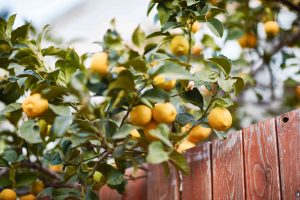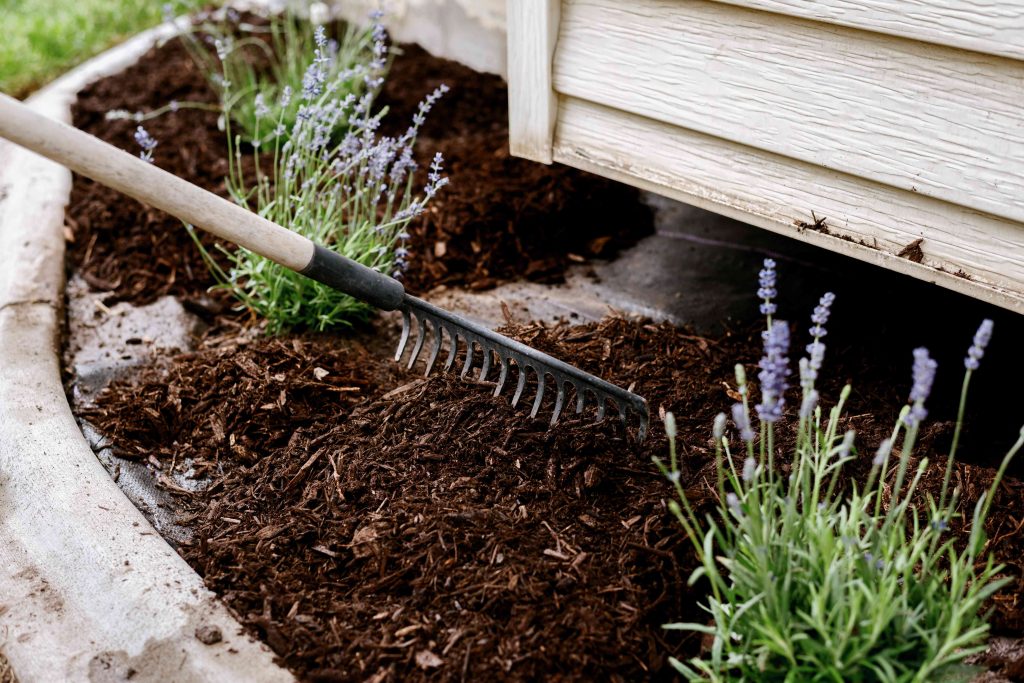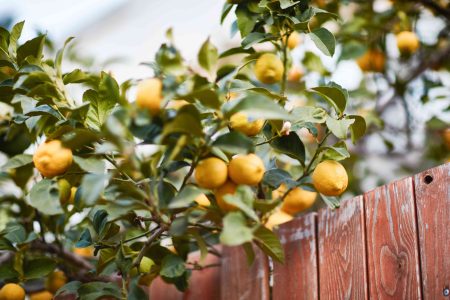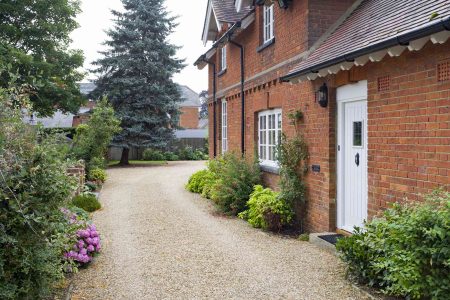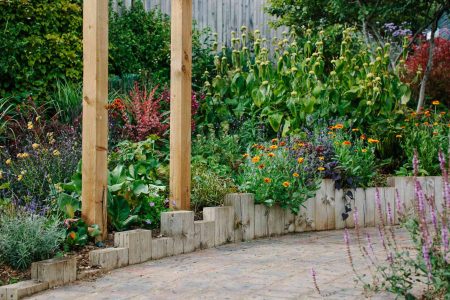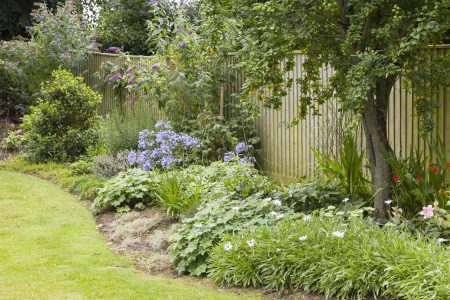Mulch is any material used to cover soil’s surface. Mulch can retain moisture in the soil, suppress or block weeds, keep the soil and plant roots cool, prevent frost heaving in winter, and make the garden bed and landscape look more attractive. Some types can also add nutrients to the soil.
Read on to learn about the different types of mulches and helpful information about the best types for your garden’s needs.
Types of Mulch
Some mulches are more aesthetically pleasing than others, while others are more functional. There are two categories of mulch, organic and inorganic, and both have advantages and disadvantages.
- Organic mulch: This natural substance is not made of anything synthetic and is the best option for adding beneficial nutrients to your garden. It can suppress weeds, but it doesn’t permanently block weeds. In general, organic mulches are best for vegetable gardens.
- Inorganic mulch: This type is a synthetic material. It is the best option for entirely blocking weeds and retaining water. It lasts longer than organic mulch but doesn’t add nutrients to the soil.
Organic Mulch
Organic mulch is made of natural ingredients and will decompose and must be replaced. However, the decomposing material will help improve the soil’s structure, drainage, nutrient-holding capacity, and organic content. The dryer and woodier the mulch, the slower it decomposes and the fewer nutrients it will give the soil.
Each type of organic mulch has its own use; here are popular sources:
- Bark, shredded, or chipped
- Pine needles
- Grass clippings
- Newspaper
- Shredded leaves
- Straw
Warning
Know where your mulch comes from. Depending on its source, mulch may contain viable weed seeds or chemicals. You don’t want mulch that will start sprouting weeds or contaminate your plants with chemicals.
Bark
Bark mulches are best used around trees and shrubs and in garden beds where you won’t be doing a lot of digging. They are also best used for front walkways and foundation plantings. These woody mulches don’t mix well into the soil, and it can become a hassle to keep moving them aside to make way for new plants. However, they will last longer than finer organic mulches.
Pine Needles
Pine needles, also known as pine straw (pine needles harvested after they’ve fallen), may slightly lower the pH of the soil, but not enough to cause plant problems. The caution with using fresh green pine needles is that they can add more acidity to the soil, but it may still be negligible. Pine needles are a good choice if you are looking for a mulch that will not become compacted but suppresses weeds and keeps moisture in the soil.
Grass Clippings
Grass clippings are best suited for remote areas of your garden where you want to suppress weeds. They have a high water content and decompose very rapidly. Grass clippings can get slimy with an unpleasant odor, so use them cautiously. Grass clippings also tend to get matted and can form a barrier preventing water penetration to the soil.
Ideally, a mulching mower distributes clippings on the lawn, adding fertility to the soil. Use your grass clippings on unplanted areas to enrich the soil, or dump them in a compost bin. However, do not compost or use grass clipping treated with herbicides or pesticides.
Newspaper
Newspapers are a popular mulch option. Most newspapers have switched to soy-based black inks and hydrogen peroxide for bleaching pulp, both eco-friendly enhancements. Avoid using newspapers with colored or glossy inks as mulch. Layered sheets of newspapers can suppress weeds, control soil temperatures, and help retain moisture. Shredded newspaper has been used for years to keep plant roots moist while shipping.
To use it in the garden: Spread a layer of four to eight sheets of newspaper around the plants. Moisten the sheets and cover the newspaper with 1 to 3 inches of another organic mulch. The weed protection should last throughout the growing season.
Shredded Leaves
Shredded leaves are nature’s favorite mulch since they are free and can be used anywhere. Leaves also entice more earthworms to your garden soil. Some gardeners don’t like the look of leaves in their gardens, and some leaf covers don’t look great in a formal setting. But if you spread a layer before plants spread out in the spring, the leaf mulch tends to blend in with the soil quickly.
Shredded leaves are perfect for woodland gardens, and if you spread a layer over your vegetable garden in the fall, it will begin decomposing over the winter. However, unshredded leaves will mat together and repel water in rainy areas. If that happens, rake and fluff them up a bit if they appear to get matted.
Straw and Hay
Straw and salt hay are popular mulches for the vegetable garden. They keep the soil and soil-borne diseases from splashing up on lower plant leaves and make paths less muddy. Straw decomposes very slowly and will last the entire growing season. It also makes a nice home for spiders and other beneficial insects that will move in and help keep the pest population in control. Finally, it’s easy to either rake up or work into the soil when it’s time to plant a new crop or put the vegetable garden to bed.
Inorganic Mulch
Synthetic and inorganic mulches do an excellent job of holding moisture and blocking weeds. They don’t add any nutrients to the soil but don’t decompose quickly or require replacing as often as organic mulches.
- Plastic and landscape fabric
- Gravel and stone
Plastic and Landscape Fabric
Plastic and landscape fabric are suitable for foundation plantings, shrubs, and trees. These plants don’t require frequent fertilization, and you won’t be working in these beds regularly, so you won’t want to worry about weeding them throughout the summer.
If you like the functionality of plastic or landscape fabric but not the look, add a thin layer of bark mulch on top of the plastic or fabric for camouflage. You will need to replace the bark as it disintegrates. Similarly, artificial grass carpets can be used in the same way.
- Plastic: A downside to plastic is it gets hot in the summer. Besides smothering weed seeds, it can also kill all the good things in the soil, including trailing plant roots and microbes. If necessary, cut holes in the plastic fabric to allow sufficient water to pass through if you see puddles accumulate on top of the plastic. Another downside is that as plastic decomposes, it can harm the soil and the environment.
- Landscape fabric: This fabric is usually a better option since it is porous and shouldn’t be a problem unless it gets blocked, causing a drainage problem. Landscape fabric is generally thinner and decomposes better than plastic. It’s sometimes made of natural materials, making it a better choice than plastic as an eco-friendly choice. After a few years, as it decomposes, it will allow weeds through it.
- Raised beds: Plastic and landscape sheets can be used to make raised beds. Consider making them the width of your plastic or fabric so you can cover the bed without seams. However, if you’re an organic gardener, you may want to forgo plastic in vegetable beds, which can contaminate the soil as it breaks down.
Watch Now: How to Install Landscape Fabric for Weed Control
Gravel and Stone
Gravel and stone work well as mulches in areas that require good drainage or beds with plants that like a little additional heat, like Mediterranean herb gardens and rain gardens. Stone is hard to remove, so give it a lot of thought before using it as a mulch. Gravel and stone are also sometimes used to cover up plastic or landscape sheeting.
-
What is the purpose of mulching?
Mulch is used for many reasons, primarily to retain moisture in the soil, keep soil temperatures consistent, reduce weed growth, and look nice for landscaping purposes.
-
What is the best mulch to use?
Organic mulch made from wood chips or bark is usually the best choice since it decomposes naturally, adding nutrients to the soil.
-
What are the disadvantages of mulching?
Mulch can block plants from emerging and suppress the reseeding of plants you want more of. It can also be a safe haven for certain garden pests like slugs. Inorganic mulch sources can leach substances that disrupt the ecosystem’s natural balance.
Read the full article here




